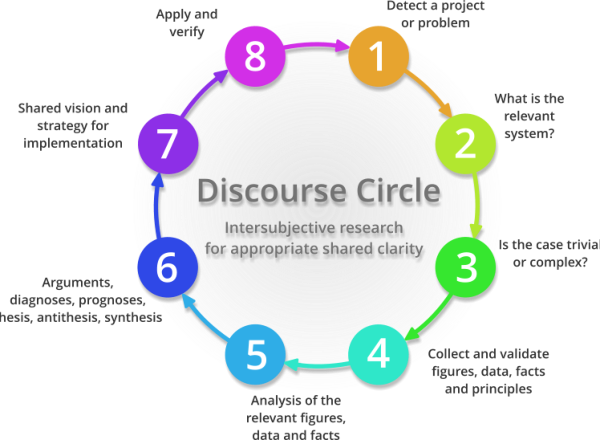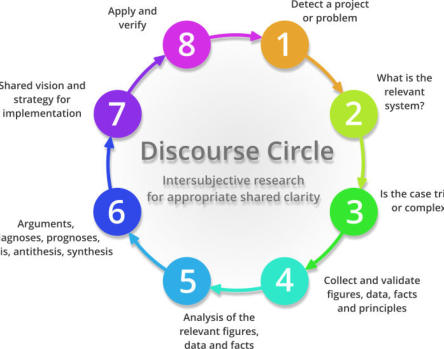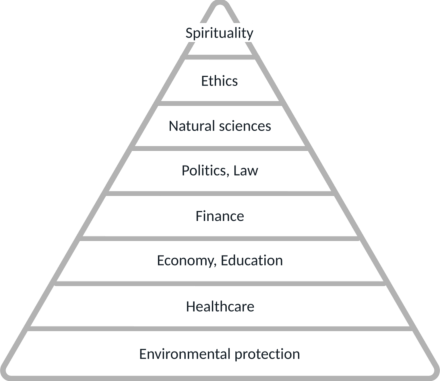Discourse

How to turn your team
into the boss

6 Hurdles to Self-Organization
Chapter 29 - The Factual Discourse



Home / hurdle 6: integral management / discourse


- The 6 Hurdles
- The Elements
- What are the Elements
- Culture Stage Model
- Gut, Head or Herart Process
- Culture Change
- List of Feelings and Needs
- Emergency Emo-Step
- Four Step Circle
- NVC Magic Circle
- Utopia Magic Circle
- Utopia and Vision
- No-Goes and Must-Haves
- Pain Points
- Consensus
- Requirement Lists
- NVC-plus Strategy
- NVC-plus Matrix
- Discourse
- Card Set
- Download-Tool-Depot
- FAQs
- Events
- Media
Successful
cooperation
is
both
a
path
and
a
goal.
Good
methods
and
tools
make
it
much
easier
for
a
team
to
organize
itself.
Encourage
your
team
to
take
the
first
steps
in
this
direction
and
experience the difference.
Factual discourse using the discourse circle
At
NVC-plus,
factual
discourse
is
just
as
important
as
personal
conversations.
For
factual
discourse,
we
can
use
the
discourse
circle
to
learn
how
to
structure
a
discourse
in
a
meaningful
way.
Most
people
believe
that
they
know
how
to
discuss.
However,
this
is
often
a
case
of
overestimating
one's
abilities.
A
discourse
is
a
meeting
of
people
who
are
searching
together,
not
a
meeting
of
many
people
with
lonely opinions.
You
can
see
in
the
diagram
of
the
discourse
circle
that
the
actual
discourse
is
at
position
6,
but
neither
begins
nor
ends
there.
A
good
discourse
is
based
on
relevant
figures,
data,
facts,
and
principles.
What
is
relevant
is
largely
determined
by
the
topic/project/problem.
Facts
require
sources
and
then
an
analysis
of
the
facts.
If
experts
from
different
fields
analyze
the
facts,
their
analysis
may
well
differ
greatly.
The
individual
theses
are
then
built
on
this
and
substantiated
with
arguments.
These
arguments
can
be
countered
with
counterarguments.
Antitheses
can
also
be
put
forward
and
supported
with
one's
own
arguments.
The
end
result
should
be
a
synthesis,
or
at
least an area of consensus that can then be used as a basis for the next decisions.
After
all,
a
good
discourse
should
enable
practical
solutions
to
be
found
(position
8).
Ultimately,
something
should
work
better
or
come
out
differently.
To
ensure
that
the
work
is
not
problem-
centered,
the
positive
(solution)
vision
is
added
in
position
7.
A
strategy
is
developed
for
this—ideally an NVC-plus strategy.
Since
people
are
less
capable
of
discourse
than
they
think
and
would
quickly
slip
into
an
exchange
of
opinions
or
a
debate,
moderation
is
recommended.
The
discourse
can
also
take
place
in
a
fishbowl
setting,
in
which
only
a
small
number
of
people
lead
the
discourse
while
the
other team members sit around them.


Every team, start-up, or company must overcome these six hurdles if it wants to organize itself
collegially in order to successfully manage projects from within the community.

The Lecture
For
a
discourse
to
make
sense,
an
adequate
common
level
of
knowledge
is
required.
Therefore,
there
will
always
be
a
need
for
a
few
lectures
or
presentations
that
raise
the
general
level
of
knowledge
in
certain
areas.
This
asymmetrical
form
can
be
described
as
a
"didactic
speech":
For
the
most
part,
one
person
reports
and
presents
for
as
long
as
necessary,
while
the
others
listen.
Equal
parts
of
speech
naturally
make
no
sense
here.
Once
knowledge
has
been
successfully
imparted, the symmetrical discourse can be continued.
The Discourse Pyramid
A
problem
can
have
different
dimensions,
but
they
do
not
have
to
be
equal.
We
can
draw
these
dimensions
as
levels
of
a
pyramid.
Which
dimensions/levels
need
to
be
considered
in
the
project?
What
is
the
best
order
of
these
levels
of
discourse
for
solving
a
problem,
for
example?
Which
layering
has
the
most
constructive effect on the discourse? The discourse pyramid It shows a top-down effect.
This
cannot
be
avoided.
Different
stratifications
produce
different
results.
We
can
ask
ourselves
which
layering would be the best:
•
for the solution
•
for the individual interests
•
for the common good
•
for the feasibility
•
for the environment
•
for awareness

Questions instead of opinions
With
the
NVC-plus
StrategyMap,
we
can
support
strategic
action
in
complex
situations.
This
can
also
be
relevant
when
leading
a
discourse.
Formulate
the
problem
as
a
question
and
then
gradually
group
other
questions
based
on
this
one.
Opinions
and
other
answers
are
left
out.
Questions
are
much
harder
to
argue
about.
Important
information
and
parameters
can
sometimes
be
added
to
the
questions
as
notes,
creating
an
NVC-plus
StrategyMap.
Here
you
can
see
a
strategy map based on classic non-violent communication: classic NVC strategy map
If
you
use
the
XMind
tool,
for
example,
you
can
easily
create
such
mind
maps.
If
you
want
to
work
together online, you can use other programs such as Miro.


Discourse
At
NVC-plus,
factual
discourse
is
just
as
important
as
personal
conversations.
For
factual
discourse,
we
can
use
the
discourse
circle
to
learn
how
to
structure
a
discourse
in
a
meaningful
way.
Most
people
believe
that
they
know
how
to
discuss.
However,
this
is
often
a
case
of
overestimating
one's
abilities.
A
discourse
is
a
meeting
of
people
who
are
searching
together,
not
a
meeting
of
many
people with lonely opinions.
You
can
see
in
the
diagram
of
the
discourse
circle
that
the
actual
discourse
is
at
position
6,
but
neither
begins
nor
ends
there.
A
good
discourse
is
based
on
relevant
figures,
data,
facts,
and
principles.
What
is
relevant
is
largely
determined
by
the
topic/project/problem.
Facts
require
sources
and
then
an
analysis
of
the
facts.
If
experts
from
different
fields
analyze
the
facts,
their
analysis
may
well
differ
greatly.
The
individual
theses
are
then
built
on
this
and
substantiated
with
arguments.
These
arguments
can
be
countered
with
counterarguments.
Antitheses
can
also
be
put
forward
and
supported
with
one's
own
arguments.
The
end
result
should
be
a
synthesis,
or
at
least
an
area
of
consensus
that
can
then
be
used
as
a
basis
for
the
next
decisions.
After
all,
a
good
discourse
should
enable
practical
solutions
to
be
found
(position
8).
Ultimately,
something
should
work
better
or
come
out
differently.
To
ensure
that
the
work
is
not
problem-centered,
the
positive
(solution)
vision
is
added
in
position
7.
A
strategy
is
developed
for
this—ideally
an
NVC-plus strategy.
Since
people
are
less
capable
of
discourse
than
they
think
and
would
quickly
slip
into
an
exchange
of
opinions
or
a
debate,
moderation
is
recommended.
The
discourse
can
also
take
place
in
a
fishbowl
setting,
in
which
only
a
small
number
of
people
lead
the
discourse
while
the
other
team
members
sit around them.

The Lecture
For
a
discourse
to
make
sense,
an
adequate
common
level
of
knowledge
is
required.
Therefore,
there
will
always
be
a
need
for
a
few
lectures
or
presentations
that
raise
the
general
level
of
knowledge
in
certain
areas.
This
asymmetrical
form
can
be
described
as
a
"didactic
speech":
For
the
most
part,
one
person
reports
and
presents
for
as
long
as
necessary,
while
the
others
listen.
Equal
parts
of
speech
naturally
make
no
sense
here.
Once
knowledge
has
been
successfully
imparted,
the
symmetrical
discourse
can
be
continued.
The Discourse Pyramid
A
problem
can
have
different
dimensions,
but
they
do
not
have
to
be
equal.
We
can
draw
these
dimensions
as
levels
of
a
pyramid.
Which
dimensions/levels
need
to
be
considered
in
the
project?
What
is
the
best
order
of
these
levels
of
discourse
for
solving
a
problem,
for
example?
Which
layering
has
the
most
constructive
effect
on
the
discourse?
The
discourse
pyramid
It
shows
a top-down effect.
This
cannot
be
avoided.
Different
stratifications
produce
different
results.
We
can
ask
ourselves
which layering would be the best:
•
for the solution
•
for the individual interests
•
for the common good
•
for the feasibility
•
for the environment
•
for awareness





d) Discourse

Questions instead of opinions
With
the
NVC-plus
StrategyMap,
we
can
support
strategic
action
in
complex
situations.
It
can
also
be
relevant
when
conducting
discourse.
Formulate
the
problem
as
a
question
and
then
gradually
group
further
questions
based
on
it.
Opinions
and
other
answers
are
left
out.
Questions
are
much
harder
to
argue
about.
Some
important
information
and
parameters
can
be
added
to
the
questions
as
notes,
creating
a
NVC-plus
strategy
map.
Here
you
can
see
a
strategy
map
based
on
classic
non-violent
communication: classic NVC strategy map
If
you
use
the
XMind
tool,
for
example,
you
can
easily
create
such
mind
maps.
If
you
want
to
work
together
online,
you
can
use
other
programs such as Miro.

Chapter 29 - The Factual Discourse


- The 6 Hurdles
- The Elements
- What are the Elements
- Culture Stage Model
- Gut, Head or Herart Process
- Culture Change
- List of Feelings and Needs
- Requirement Lists
- NVC Magic Circle
- Utopia Magic Circle
- Emergency Emo-Step
- Four Step Circle
- Utopia and Vision
- No-Goes and Must-Haves
- Pain Points
- Consensus
- NVC-plus Strategy
- NVC-plus Matrix
- Discourse
- Card Set
- Download-Tool-Depot
- FAQs
- Events
- Media
Factual discourse using the discourse
circle
Successful
cooperation
is
both
a
path
and
a
goal.
Good
methods
and
tools
make
it
much
easier
for
a
team
to
organize
itself.
Encourage
your
team
to
take
the
first
steps
in
this
direction
and
experience
the
difference.









































